Indigenous Health and Cultural Safety
VerifiedAdded on 2020/02/24
|11
|3052
|112
AI Summary
This assignment delves into the critical issues surrounding Indigenous health in Australia. It examines the historical context of colonization and its lasting impact on Indigenous well-being. The focus is on understanding cultural safety as a core principle in healthcare delivery to Indigenous populations. Students will analyze various resources, including academic articles and government reports, to gain insights into the social determinants of health that disproportionately affect Indigenous Australians. The assignment emphasizes the importance of culturally appropriate communication strategies and ethical considerations when working with Indigenous communities.
Contribute Materials
Your contribution can guide someone’s learning journey. Share your
documents today.
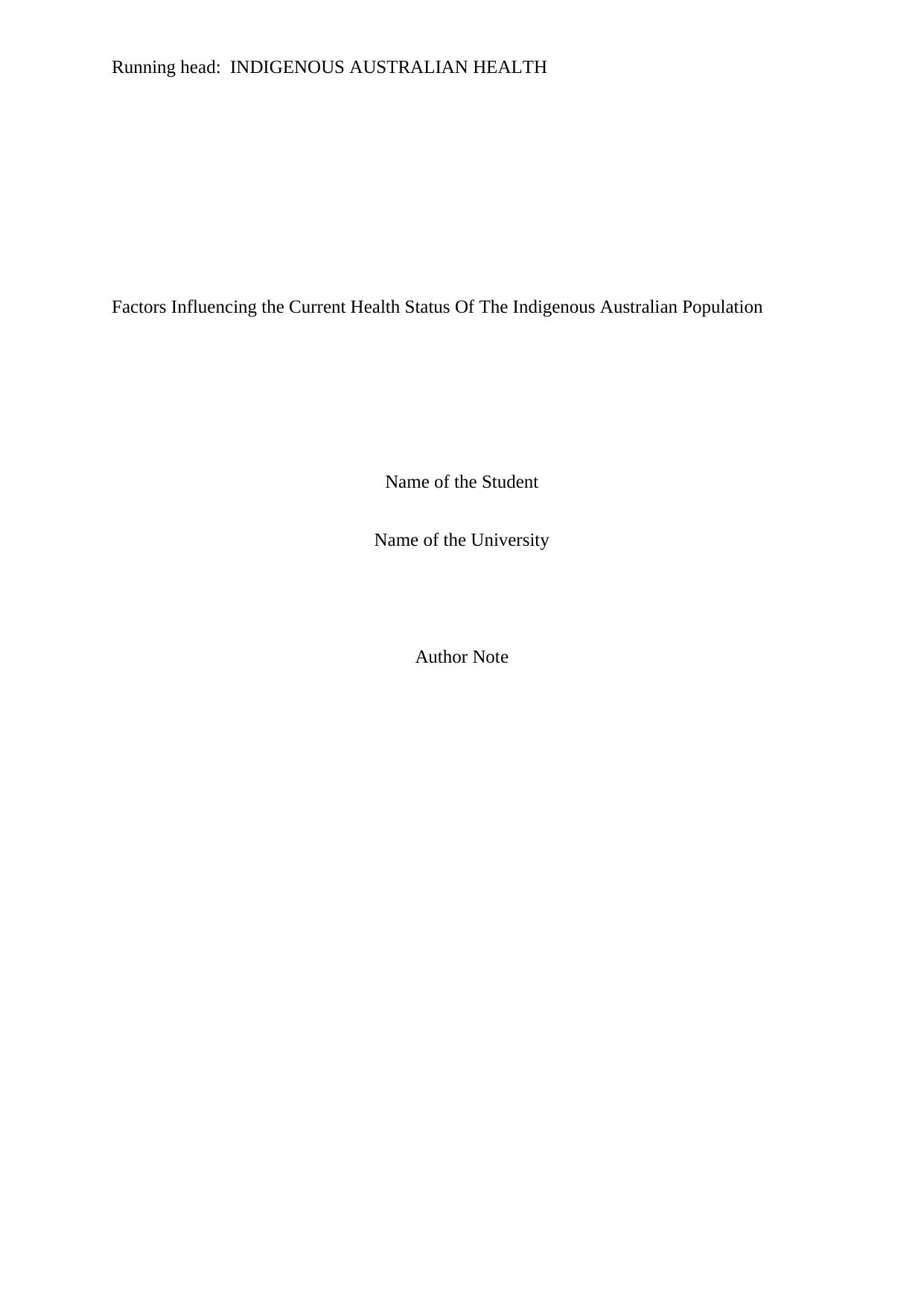
Running head: INDIGENOUS AUSTRALIAN HEALTH
Factors Influencing the Current Health Status Of The Indigenous Australian Population
Name of the Student
Name of the University
Author Note
Factors Influencing the Current Health Status Of The Indigenous Australian Population
Name of the Student
Name of the University
Author Note
Secure Best Marks with AI Grader
Need help grading? Try our AI Grader for instant feedback on your assignments.
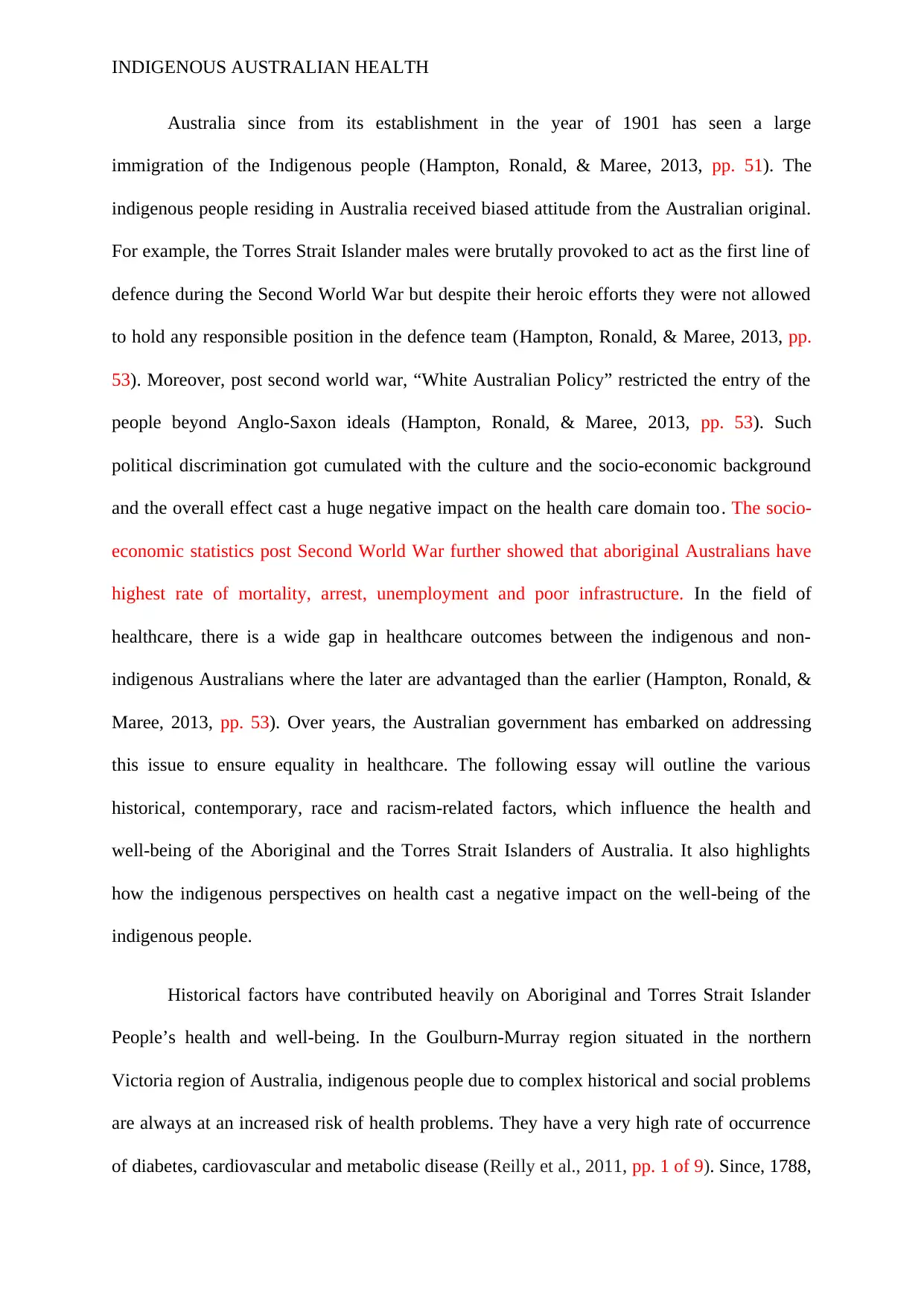
INDIGENOUS AUSTRALIAN HEALTH
Australia since from its establishment in the year of 1901 has seen a large
immigration of the Indigenous people (Hampton, Ronald, & Maree, 2013, pp. 51). The
indigenous people residing in Australia received biased attitude from the Australian original.
For example, the Torres Strait Islander males were brutally provoked to act as the first line of
defence during the Second World War but despite their heroic efforts they were not allowed
to hold any responsible position in the defence team (Hampton, Ronald, & Maree, 2013, pp.
53). Moreover, post second world war, “White Australian Policy” restricted the entry of the
people beyond Anglo-Saxon ideals (Hampton, Ronald, & Maree, 2013, pp. 53). Such
political discrimination got cumulated with the culture and the socio-economic background
and the overall effect cast a huge negative impact on the health care domain too. The socio-
economic statistics post Second World War further showed that aboriginal Australians have
highest rate of mortality, arrest, unemployment and poor infrastructure. In the field of
healthcare, there is a wide gap in healthcare outcomes between the indigenous and non-
indigenous Australians where the later are advantaged than the earlier (Hampton, Ronald, &
Maree, 2013, pp. 53). Over years, the Australian government has embarked on addressing
this issue to ensure equality in healthcare. The following essay will outline the various
historical, contemporary, race and racism-related factors, which influence the health and
well-being of the Aboriginal and the Torres Strait Islanders of Australia. It also highlights
how the indigenous perspectives on health cast a negative impact on the well-being of the
indigenous people.
Historical factors have contributed heavily on Aboriginal and Torres Strait Islander
People’s health and well-being. In the Goulburn-Murray region situated in the northern
Victoria region of Australia, indigenous people due to complex historical and social problems
are always at an increased risk of health problems. They have a very high rate of occurrence
of diabetes, cardiovascular and metabolic disease (Reilly et al., 2011, pp. 1 of 9). Since, 1788,
Australia since from its establishment in the year of 1901 has seen a large
immigration of the Indigenous people (Hampton, Ronald, & Maree, 2013, pp. 51). The
indigenous people residing in Australia received biased attitude from the Australian original.
For example, the Torres Strait Islander males were brutally provoked to act as the first line of
defence during the Second World War but despite their heroic efforts they were not allowed
to hold any responsible position in the defence team (Hampton, Ronald, & Maree, 2013, pp.
53). Moreover, post second world war, “White Australian Policy” restricted the entry of the
people beyond Anglo-Saxon ideals (Hampton, Ronald, & Maree, 2013, pp. 53). Such
political discrimination got cumulated with the culture and the socio-economic background
and the overall effect cast a huge negative impact on the health care domain too. The socio-
economic statistics post Second World War further showed that aboriginal Australians have
highest rate of mortality, arrest, unemployment and poor infrastructure. In the field of
healthcare, there is a wide gap in healthcare outcomes between the indigenous and non-
indigenous Australians where the later are advantaged than the earlier (Hampton, Ronald, &
Maree, 2013, pp. 53). Over years, the Australian government has embarked on addressing
this issue to ensure equality in healthcare. The following essay will outline the various
historical, contemporary, race and racism-related factors, which influence the health and
well-being of the Aboriginal and the Torres Strait Islanders of Australia. It also highlights
how the indigenous perspectives on health cast a negative impact on the well-being of the
indigenous people.
Historical factors have contributed heavily on Aboriginal and Torres Strait Islander
People’s health and well-being. In the Goulburn-Murray region situated in the northern
Victoria region of Australia, indigenous people due to complex historical and social problems
are always at an increased risk of health problems. They have a very high rate of occurrence
of diabetes, cardiovascular and metabolic disease (Reilly et al., 2011, pp. 1 of 9). Since, 1788,
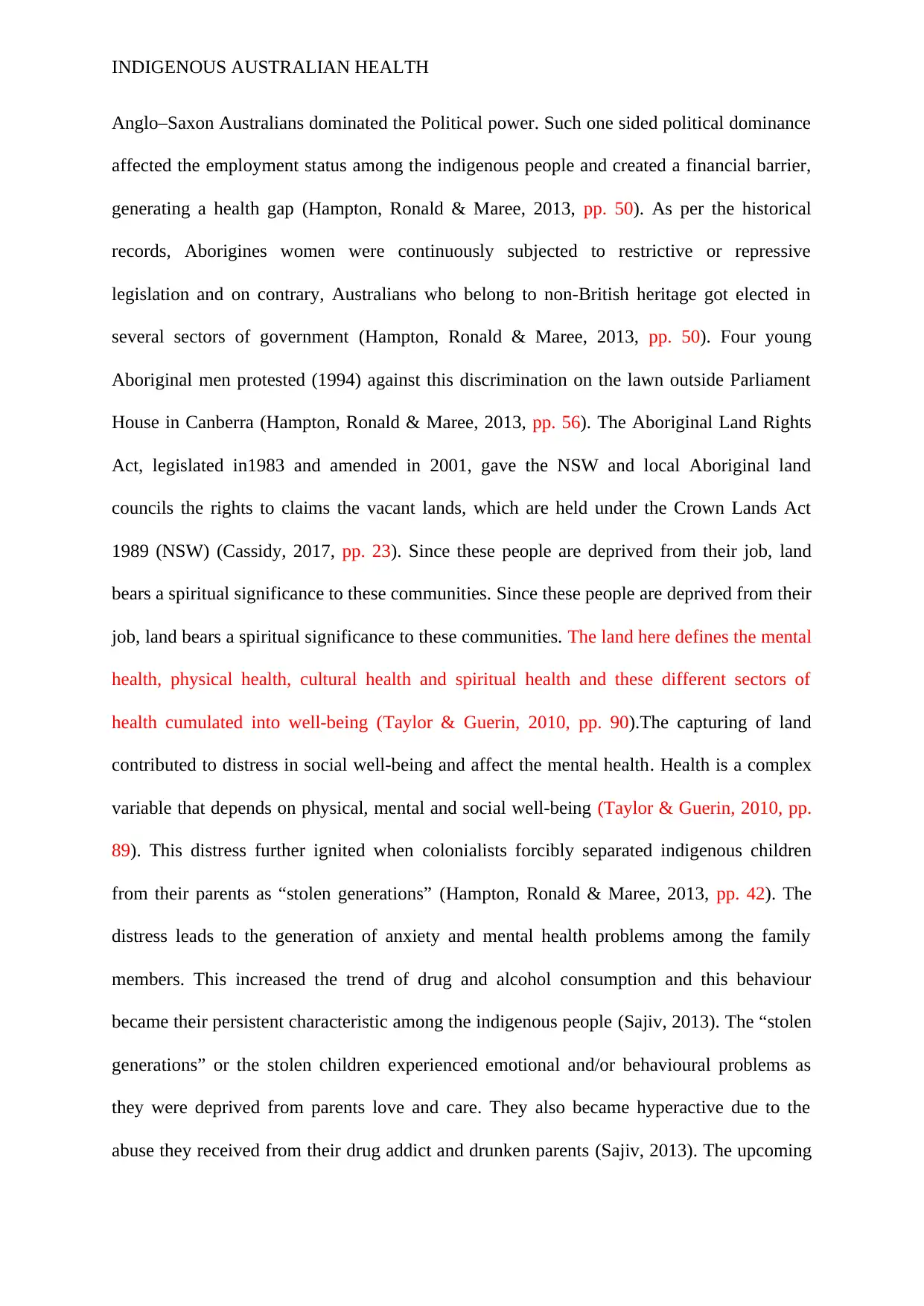
INDIGENOUS AUSTRALIAN HEALTH
Anglo–Saxon Australians dominated the Political power. Such one sided political dominance
affected the employment status among the indigenous people and created a financial barrier,
generating a health gap (Hampton, Ronald & Maree, 2013, pp. 50). As per the historical
records, Aborigines women were continuously subjected to restrictive or repressive
legislation and on contrary, Australians who belong to non-British heritage got elected in
several sectors of government (Hampton, Ronald & Maree, 2013, pp. 50). Four young
Aboriginal men protested (1994) against this discrimination on the lawn outside Parliament
House in Canberra (Hampton, Ronald & Maree, 2013, pp. 56). The Aboriginal Land Rights
Act, legislated in1983 and amended in 2001, gave the NSW and local Aboriginal land
councils the rights to claims the vacant lands, which are held under the Crown Lands Act
1989 (NSW) (Cassidy, 2017, pp. 23). Since these people are deprived from their job, land
bears a spiritual significance to these communities. Since these people are deprived from their
job, land bears a spiritual significance to these communities. The land here defines the mental
health, physical health, cultural health and spiritual health and these different sectors of
health cumulated into well-being (Taylor & Guerin, 2010, pp. 90).The capturing of land
contributed to distress in social well-being and affect the mental health. Health is a complex
variable that depends on physical, mental and social well-being (Taylor & Guerin, 2010, pp.
89). This distress further ignited when colonialists forcibly separated indigenous children
from their parents as “stolen generations” (Hampton, Ronald & Maree, 2013, pp. 42). The
distress leads to the generation of anxiety and mental health problems among the family
members. This increased the trend of drug and alcohol consumption and this behaviour
became their persistent characteristic among the indigenous people (Sajiv, 2013). The “stolen
generations” or the stolen children experienced emotional and/or behavioural problems as
they were deprived from parents love and care. They also became hyperactive due to the
abuse they received from their drug addict and drunken parents (Sajiv, 2013). The upcoming
Anglo–Saxon Australians dominated the Political power. Such one sided political dominance
affected the employment status among the indigenous people and created a financial barrier,
generating a health gap (Hampton, Ronald & Maree, 2013, pp. 50). As per the historical
records, Aborigines women were continuously subjected to restrictive or repressive
legislation and on contrary, Australians who belong to non-British heritage got elected in
several sectors of government (Hampton, Ronald & Maree, 2013, pp. 50). Four young
Aboriginal men protested (1994) against this discrimination on the lawn outside Parliament
House in Canberra (Hampton, Ronald & Maree, 2013, pp. 56). The Aboriginal Land Rights
Act, legislated in1983 and amended in 2001, gave the NSW and local Aboriginal land
councils the rights to claims the vacant lands, which are held under the Crown Lands Act
1989 (NSW) (Cassidy, 2017, pp. 23). Since these people are deprived from their job, land
bears a spiritual significance to these communities. Since these people are deprived from their
job, land bears a spiritual significance to these communities. The land here defines the mental
health, physical health, cultural health and spiritual health and these different sectors of
health cumulated into well-being (Taylor & Guerin, 2010, pp. 90).The capturing of land
contributed to distress in social well-being and affect the mental health. Health is a complex
variable that depends on physical, mental and social well-being (Taylor & Guerin, 2010, pp.
89). This distress further ignited when colonialists forcibly separated indigenous children
from their parents as “stolen generations” (Hampton, Ronald & Maree, 2013, pp. 42). The
distress leads to the generation of anxiety and mental health problems among the family
members. This increased the trend of drug and alcohol consumption and this behaviour
became their persistent characteristic among the indigenous people (Sajiv, 2013). The “stolen
generations” or the stolen children experienced emotional and/or behavioural problems as
they were deprived from parents love and care. They also became hyperactive due to the
abuse they received from their drug addict and drunken parents (Sajiv, 2013). The upcoming
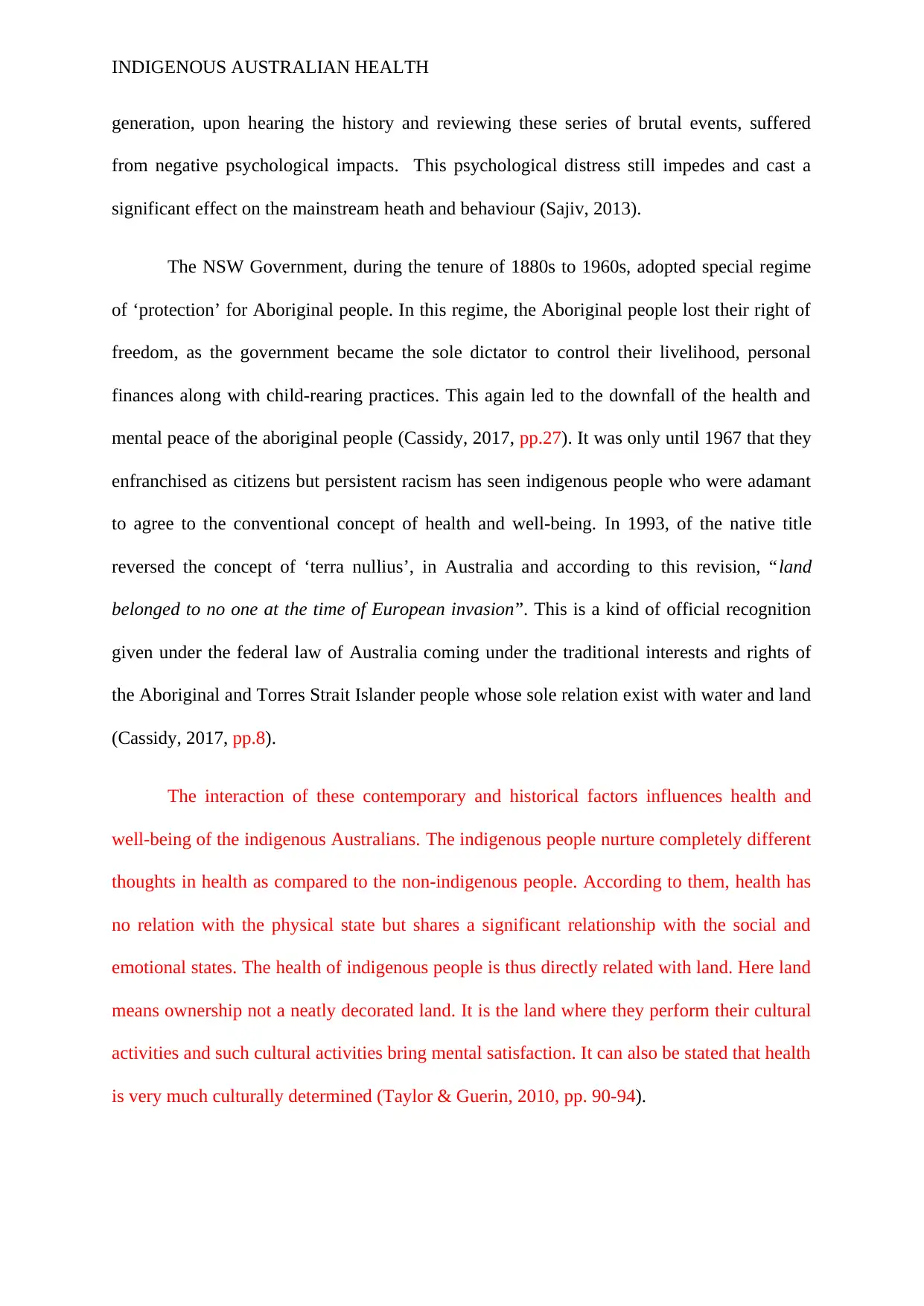
INDIGENOUS AUSTRALIAN HEALTH
generation, upon hearing the history and reviewing these series of brutal events, suffered
from negative psychological impacts. This psychological distress still impedes and cast a
significant effect on the mainstream heath and behaviour (Sajiv, 2013).
The NSW Government, during the tenure of 1880s to 1960s, adopted special regime
of ‘protection’ for Aboriginal people. In this regime, the Aboriginal people lost their right of
freedom, as the government became the sole dictator to control their livelihood, personal
finances along with child-rearing practices. This again led to the downfall of the health and
mental peace of the aboriginal people (Cassidy, 2017, pp.27). It was only until 1967 that they
enfranchised as citizens but persistent racism has seen indigenous people who were adamant
to agree to the conventional concept of health and well-being. In 1993, of the native title
reversed the concept of ‘terra nullius’, in Australia and according to this revision, “land
belonged to no one at the time of European invasion”. This is a kind of official recognition
given under the federal law of Australia coming under the traditional interests and rights of
the Aboriginal and Torres Strait Islander people whose sole relation exist with water and land
(Cassidy, 2017, pp.8).
The interaction of these contemporary and historical factors influences health and
well-being of the indigenous Australians. The indigenous people nurture completely different
thoughts in health as compared to the non-indigenous people. According to them, health has
no relation with the physical state but shares a significant relationship with the social and
emotional states. The health of indigenous people is thus directly related with land. Here land
means ownership not a neatly decorated land. It is the land where they perform their cultural
activities and such cultural activities bring mental satisfaction. It can also be stated that health
is very much culturally determined (Taylor & Guerin, 2010, pp. 90-94).
generation, upon hearing the history and reviewing these series of brutal events, suffered
from negative psychological impacts. This psychological distress still impedes and cast a
significant effect on the mainstream heath and behaviour (Sajiv, 2013).
The NSW Government, during the tenure of 1880s to 1960s, adopted special regime
of ‘protection’ for Aboriginal people. In this regime, the Aboriginal people lost their right of
freedom, as the government became the sole dictator to control their livelihood, personal
finances along with child-rearing practices. This again led to the downfall of the health and
mental peace of the aboriginal people (Cassidy, 2017, pp.27). It was only until 1967 that they
enfranchised as citizens but persistent racism has seen indigenous people who were adamant
to agree to the conventional concept of health and well-being. In 1993, of the native title
reversed the concept of ‘terra nullius’, in Australia and according to this revision, “land
belonged to no one at the time of European invasion”. This is a kind of official recognition
given under the federal law of Australia coming under the traditional interests and rights of
the Aboriginal and Torres Strait Islander people whose sole relation exist with water and land
(Cassidy, 2017, pp.8).
The interaction of these contemporary and historical factors influences health and
well-being of the indigenous Australians. The indigenous people nurture completely different
thoughts in health as compared to the non-indigenous people. According to them, health has
no relation with the physical state but shares a significant relationship with the social and
emotional states. The health of indigenous people is thus directly related with land. Here land
means ownership not a neatly decorated land. It is the land where they perform their cultural
activities and such cultural activities bring mental satisfaction. It can also be stated that health
is very much culturally determined (Taylor & Guerin, 2010, pp. 90-94).
Secure Best Marks with AI Grader
Need help grading? Try our AI Grader for instant feedback on your assignments.
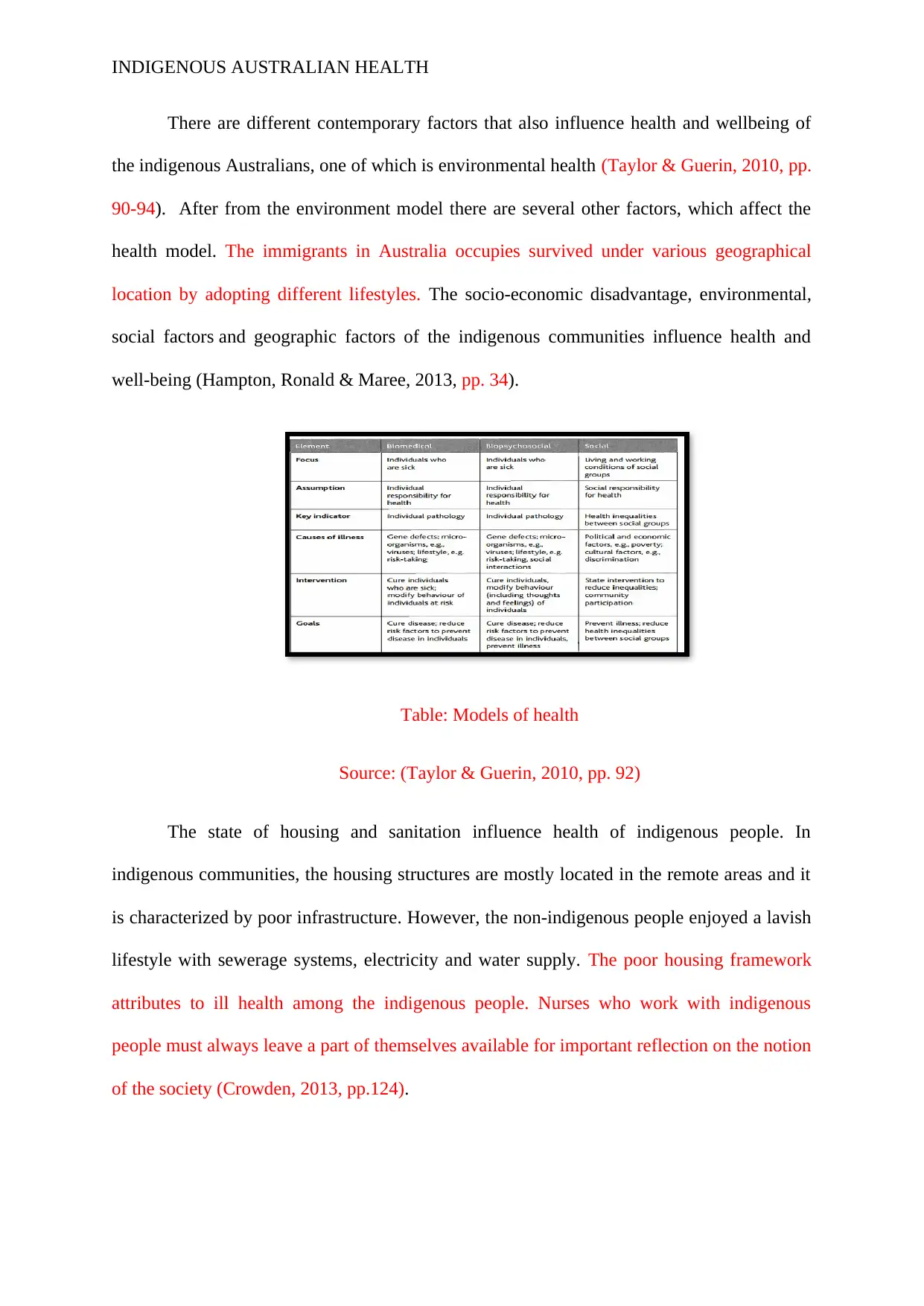
INDIGENOUS AUSTRALIAN HEALTH
There are different contemporary factors that also influence health and wellbeing of
the indigenous Australians, one of which is environmental health (Taylor & Guerin, 2010, pp.
90-94). After from the environment model there are several other factors, which affect the
health model. The immigrants in Australia occupies survived under various geographical
location by adopting different lifestyles. The socio-economic disadvantage, environmental,
social factors and geographic factors of the indigenous communities influence health and
well-being (Hampton, Ronald & Maree, 2013, pp. 34).
Table: Models of health
Source: (Taylor & Guerin, 2010, pp. 92)
The state of housing and sanitation influence health of indigenous people. In
indigenous communities, the housing structures are mostly located in the remote areas and it
is characterized by poor infrastructure. However, the non-indigenous people enjoyed a lavish
lifestyle with sewerage systems, electricity and water supply. The poor housing framework
attributes to ill health among the indigenous people. Nurses who work with indigenous
people must always leave a part of themselves available for important reflection on the notion
of the society (Crowden, 2013, pp.124).
There are different contemporary factors that also influence health and wellbeing of
the indigenous Australians, one of which is environmental health (Taylor & Guerin, 2010, pp.
90-94). After from the environment model there are several other factors, which affect the
health model. The immigrants in Australia occupies survived under various geographical
location by adopting different lifestyles. The socio-economic disadvantage, environmental,
social factors and geographic factors of the indigenous communities influence health and
well-being (Hampton, Ronald & Maree, 2013, pp. 34).
Table: Models of health
Source: (Taylor & Guerin, 2010, pp. 92)
The state of housing and sanitation influence health of indigenous people. In
indigenous communities, the housing structures are mostly located in the remote areas and it
is characterized by poor infrastructure. However, the non-indigenous people enjoyed a lavish
lifestyle with sewerage systems, electricity and water supply. The poor housing framework
attributes to ill health among the indigenous people. Nurses who work with indigenous
people must always leave a part of themselves available for important reflection on the notion
of the society (Crowden, 2013, pp.124).
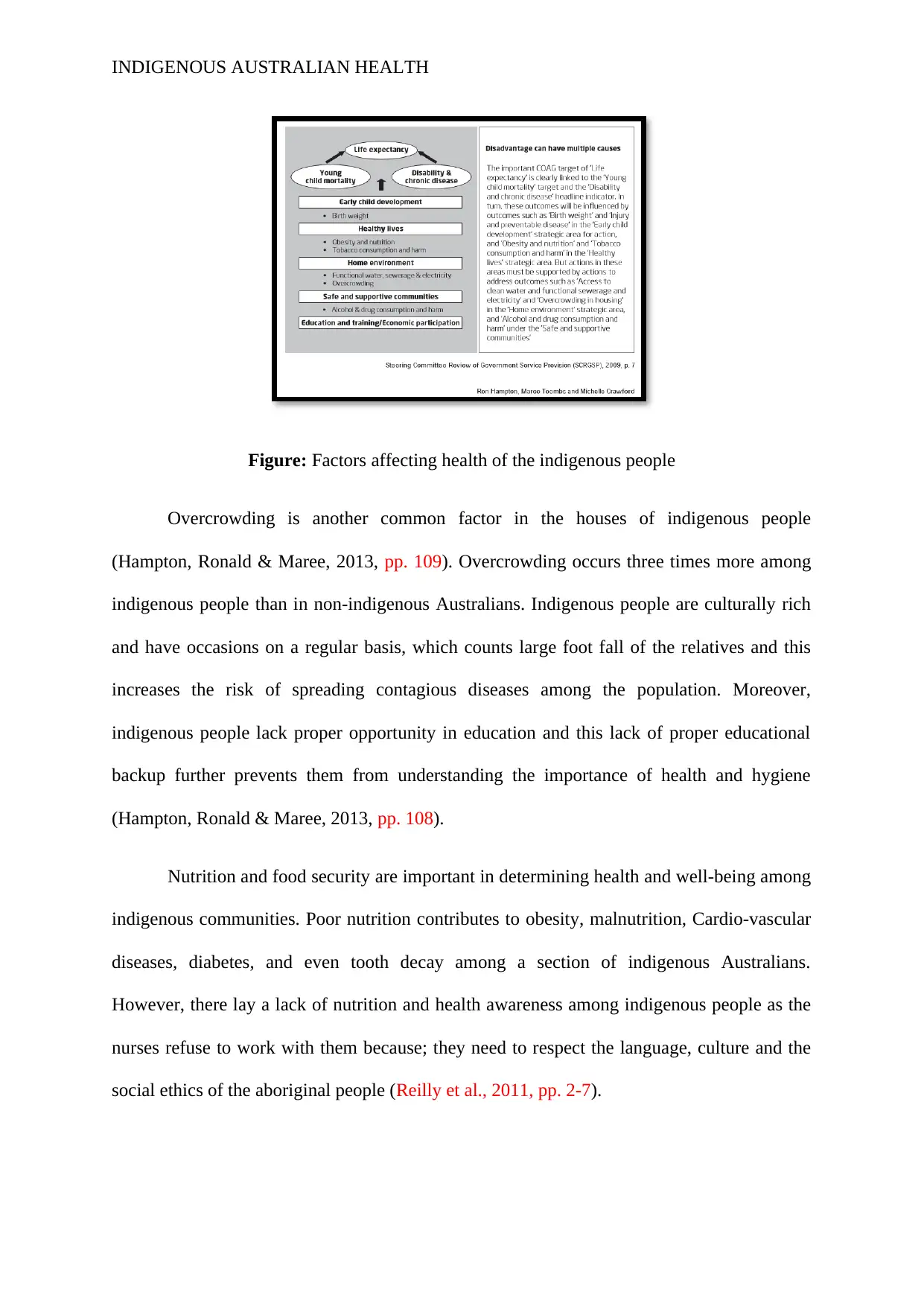
INDIGENOUS AUSTRALIAN HEALTH
Figure: Factors affecting health of the indigenous people
Overcrowding is another common factor in the houses of indigenous people
(Hampton, Ronald & Maree, 2013, pp. 109). Overcrowding occurs three times more among
indigenous people than in non-indigenous Australians. Indigenous people are culturally rich
and have occasions on a regular basis, which counts large foot fall of the relatives and this
increases the risk of spreading contagious diseases among the population. Moreover,
indigenous people lack proper opportunity in education and this lack of proper educational
backup further prevents them from understanding the importance of health and hygiene
(Hampton, Ronald & Maree, 2013, pp. 108).
Nutrition and food security are important in determining health and well-being among
indigenous communities. Poor nutrition contributes to obesity, malnutrition, Cardio-vascular
diseases, diabetes, and even tooth decay among a section of indigenous Australians.
However, there lay a lack of nutrition and health awareness among indigenous people as the
nurses refuse to work with them because; they need to respect the language, culture and the
social ethics of the aboriginal people (Reilly et al., 2011, pp. 2-7).
Figure: Factors affecting health of the indigenous people
Overcrowding is another common factor in the houses of indigenous people
(Hampton, Ronald & Maree, 2013, pp. 109). Overcrowding occurs three times more among
indigenous people than in non-indigenous Australians. Indigenous people are culturally rich
and have occasions on a regular basis, which counts large foot fall of the relatives and this
increases the risk of spreading contagious diseases among the population. Moreover,
indigenous people lack proper opportunity in education and this lack of proper educational
backup further prevents them from understanding the importance of health and hygiene
(Hampton, Ronald & Maree, 2013, pp. 108).
Nutrition and food security are important in determining health and well-being among
indigenous communities. Poor nutrition contributes to obesity, malnutrition, Cardio-vascular
diseases, diabetes, and even tooth decay among a section of indigenous Australians.
However, there lay a lack of nutrition and health awareness among indigenous people as the
nurses refuse to work with them because; they need to respect the language, culture and the
social ethics of the aboriginal people (Reilly et al., 2011, pp. 2-7).
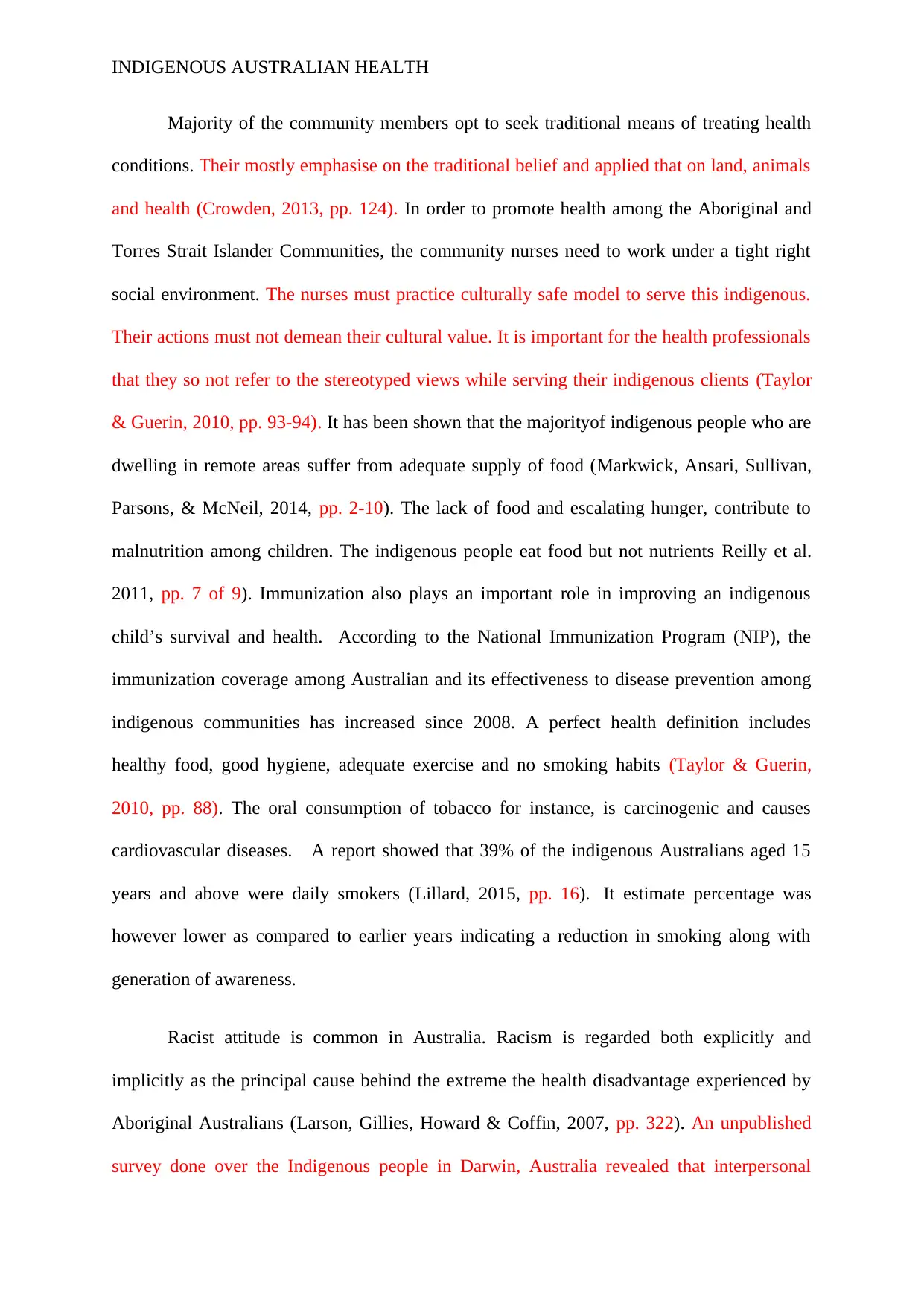
INDIGENOUS AUSTRALIAN HEALTH
Majority of the community members opt to seek traditional means of treating health
conditions. Their mostly emphasise on the traditional belief and applied that on land, animals
and health (Crowden, 2013, pp. 124). In order to promote health among the Aboriginal and
Torres Strait Islander Communities, the community nurses need to work under a tight right
social environment. The nurses must practice culturally safe model to serve this indigenous.
Their actions must not demean their cultural value. It is important for the health professionals
that they so not refer to the stereotyped views while serving their indigenous clients (Taylor
& Guerin, 2010, pp. 93-94). It has been shown that the majorityof indigenous people who are
dwelling in remote areas suffer from adequate supply of food (Markwick, Ansari, Sullivan,
Parsons, & McNeil, 2014, pp. 2-10). The lack of food and escalating hunger, contribute to
malnutrition among children. The indigenous people eat food but not nutrients Reilly et al.
2011, pp. 7 of 9). Immunization also plays an important role in improving an indigenous
child’s survival and health. According to the National Immunization Program (NIP), the
immunization coverage among Australian and its effectiveness to disease prevention among
indigenous communities has increased since 2008. A perfect health definition includes
healthy food, good hygiene, adequate exercise and no smoking habits (Taylor & Guerin,
2010, pp. 88). The oral consumption of tobacco for instance, is carcinogenic and causes
cardiovascular diseases. A report showed that 39% of the indigenous Australians aged 15
years and above were daily smokers (Lillard, 2015, pp. 16). It estimate percentage was
however lower as compared to earlier years indicating a reduction in smoking along with
generation of awareness.
Racist attitude is common in Australia. Racism is regarded both explicitly and
implicitly as the principal cause behind the extreme the health disadvantage experienced by
Aboriginal Australians (Larson, Gillies, Howard & Coffin, 2007, pp. 322). An unpublished
survey done over the Indigenous people in Darwin, Australia revealed that interpersonal
Majority of the community members opt to seek traditional means of treating health
conditions. Their mostly emphasise on the traditional belief and applied that on land, animals
and health (Crowden, 2013, pp. 124). In order to promote health among the Aboriginal and
Torres Strait Islander Communities, the community nurses need to work under a tight right
social environment. The nurses must practice culturally safe model to serve this indigenous.
Their actions must not demean their cultural value. It is important for the health professionals
that they so not refer to the stereotyped views while serving their indigenous clients (Taylor
& Guerin, 2010, pp. 93-94). It has been shown that the majorityof indigenous people who are
dwelling in remote areas suffer from adequate supply of food (Markwick, Ansari, Sullivan,
Parsons, & McNeil, 2014, pp. 2-10). The lack of food and escalating hunger, contribute to
malnutrition among children. The indigenous people eat food but not nutrients Reilly et al.
2011, pp. 7 of 9). Immunization also plays an important role in improving an indigenous
child’s survival and health. According to the National Immunization Program (NIP), the
immunization coverage among Australian and its effectiveness to disease prevention among
indigenous communities has increased since 2008. A perfect health definition includes
healthy food, good hygiene, adequate exercise and no smoking habits (Taylor & Guerin,
2010, pp. 88). The oral consumption of tobacco for instance, is carcinogenic and causes
cardiovascular diseases. A report showed that 39% of the indigenous Australians aged 15
years and above were daily smokers (Lillard, 2015, pp. 16). It estimate percentage was
however lower as compared to earlier years indicating a reduction in smoking along with
generation of awareness.
Racist attitude is common in Australia. Racism is regarded both explicitly and
implicitly as the principal cause behind the extreme the health disadvantage experienced by
Aboriginal Australians (Larson, Gillies, Howard & Coffin, 2007, pp. 322). An unpublished
survey done over the Indigenous people in Darwin, Australia revealed that interpersonal
Paraphrase This Document
Need a fresh take? Get an instant paraphrase of this document with our AI Paraphraser
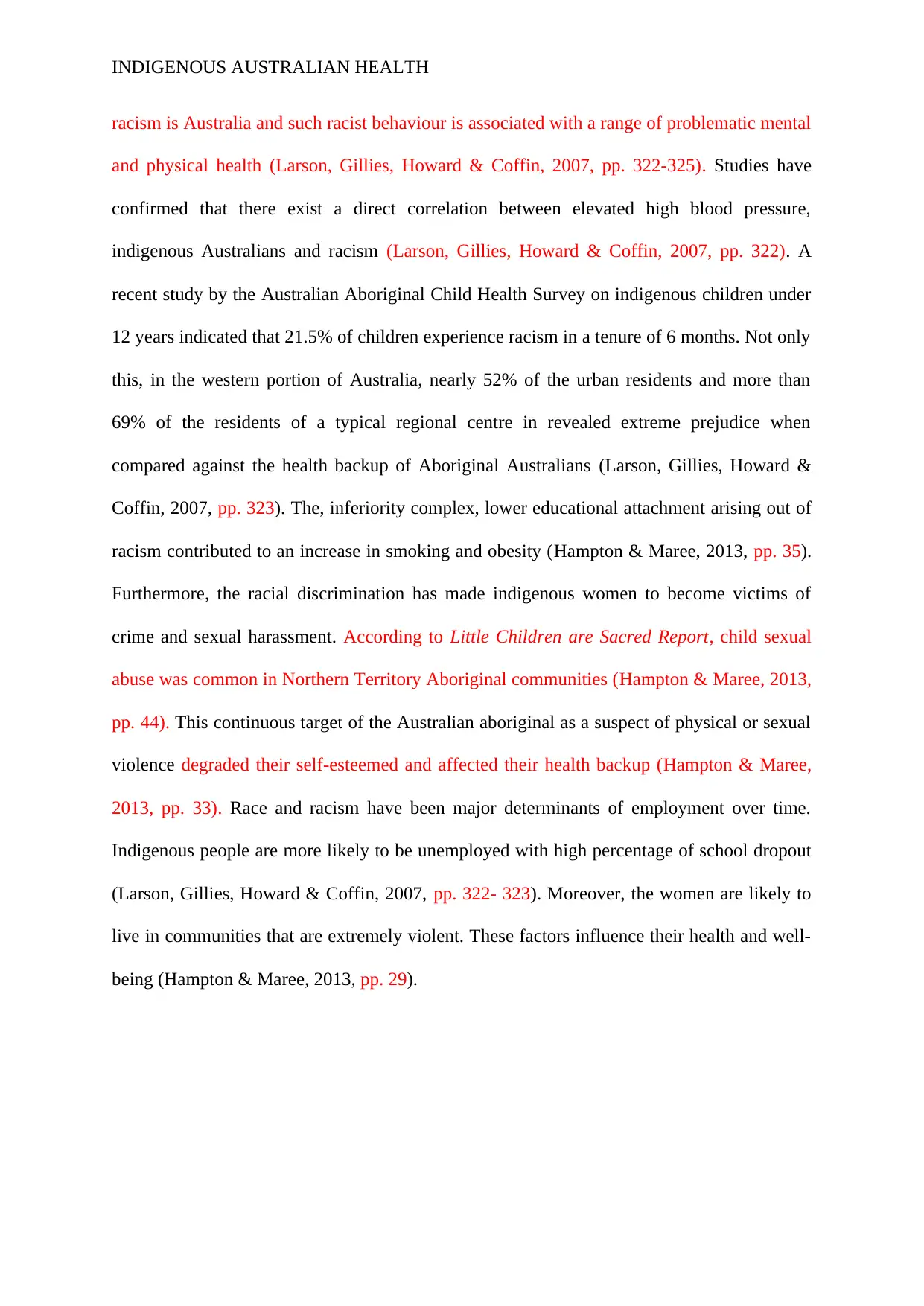
INDIGENOUS AUSTRALIAN HEALTH
racism is Australia and such racist behaviour is associated with a range of problematic mental
and physical health (Larson, Gillies, Howard & Coffin, 2007, pp. 322-325). Studies have
confirmed that there exist a direct correlation between elevated high blood pressure,
indigenous Australians and racism (Larson, Gillies, Howard & Coffin, 2007, pp. 322). A
recent study by the Australian Aboriginal Child Health Survey on indigenous children under
12 years indicated that 21.5% of children experience racism in a tenure of 6 months. Not only
this, in the western portion of Australia, nearly 52% of the urban residents and more than
69% of the residents of a typical regional centre in revealed extreme prejudice when
compared against the health backup of Aboriginal Australians (Larson, Gillies, Howard &
Coffin, 2007, pp. 323). The, inferiority complex, lower educational attachment arising out of
racism contributed to an increase in smoking and obesity (Hampton & Maree, 2013, pp. 35).
Furthermore, the racial discrimination has made indigenous women to become victims of
crime and sexual harassment. According to Little Children are Sacred Report, child sexual
abuse was common in Northern Territory Aboriginal communities (Hampton & Maree, 2013,
pp. 44). This continuous target of the Australian aboriginal as a suspect of physical or sexual
violence degraded their self-esteemed and affected their health backup (Hampton & Maree,
2013, pp. 33). Race and racism have been major determinants of employment over time.
Indigenous people are more likely to be unemployed with high percentage of school dropout
(Larson, Gillies, Howard & Coffin, 2007, pp. 322- 323). Moreover, the women are likely to
live in communities that are extremely violent. These factors influence their health and well-
being (Hampton & Maree, 2013, pp. 29).
racism is Australia and such racist behaviour is associated with a range of problematic mental
and physical health (Larson, Gillies, Howard & Coffin, 2007, pp. 322-325). Studies have
confirmed that there exist a direct correlation between elevated high blood pressure,
indigenous Australians and racism (Larson, Gillies, Howard & Coffin, 2007, pp. 322). A
recent study by the Australian Aboriginal Child Health Survey on indigenous children under
12 years indicated that 21.5% of children experience racism in a tenure of 6 months. Not only
this, in the western portion of Australia, nearly 52% of the urban residents and more than
69% of the residents of a typical regional centre in revealed extreme prejudice when
compared against the health backup of Aboriginal Australians (Larson, Gillies, Howard &
Coffin, 2007, pp. 323). The, inferiority complex, lower educational attachment arising out of
racism contributed to an increase in smoking and obesity (Hampton & Maree, 2013, pp. 35).
Furthermore, the racial discrimination has made indigenous women to become victims of
crime and sexual harassment. According to Little Children are Sacred Report, child sexual
abuse was common in Northern Territory Aboriginal communities (Hampton & Maree, 2013,
pp. 44). This continuous target of the Australian aboriginal as a suspect of physical or sexual
violence degraded their self-esteemed and affected their health backup (Hampton & Maree,
2013, pp. 33). Race and racism have been major determinants of employment over time.
Indigenous people are more likely to be unemployed with high percentage of school dropout
(Larson, Gillies, Howard & Coffin, 2007, pp. 322- 323). Moreover, the women are likely to
live in communities that are extremely violent. These factors influence their health and well-
being (Hampton & Maree, 2013, pp. 29).
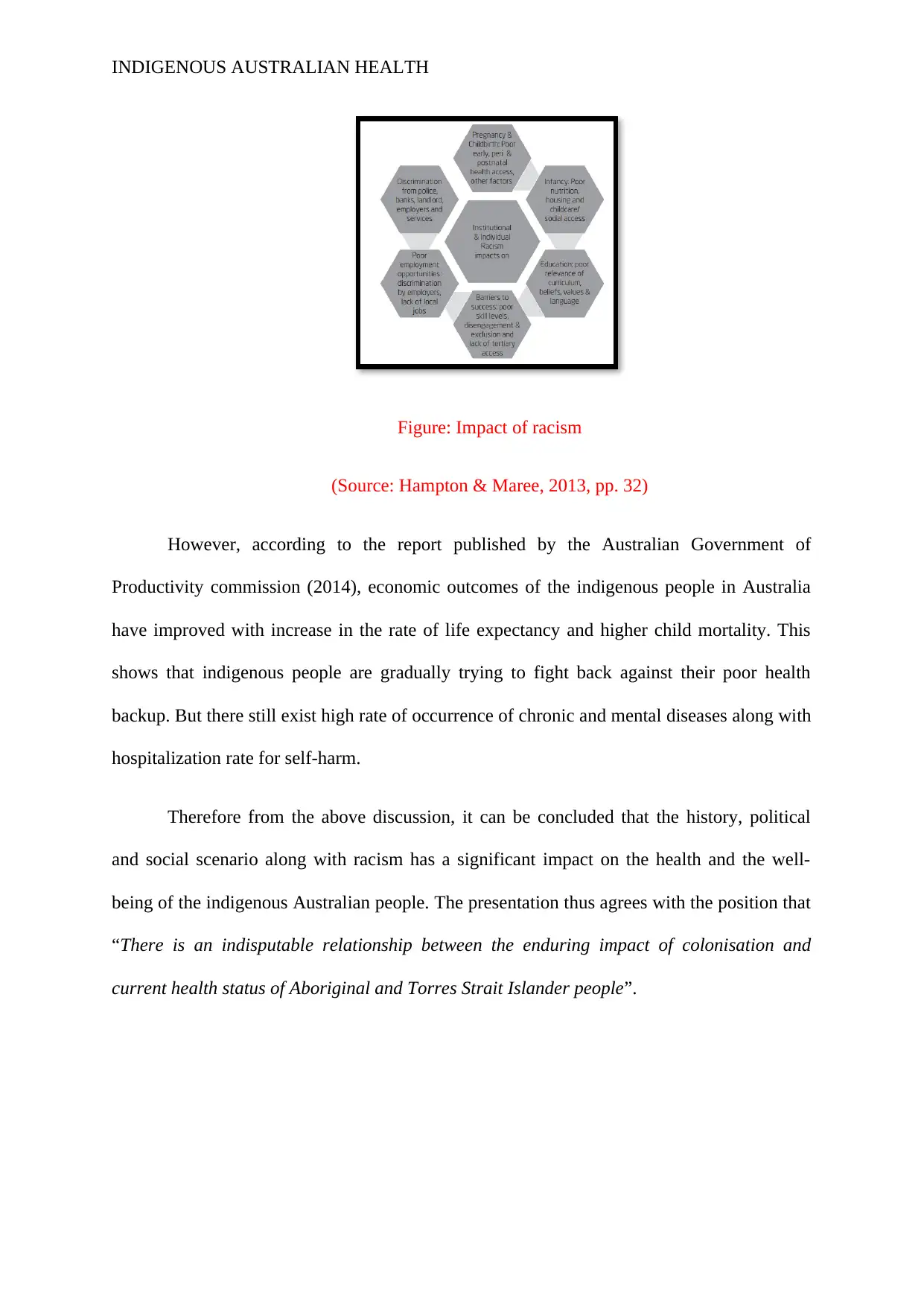
INDIGENOUS AUSTRALIAN HEALTH
Figure: Impact of racism
(Source: Hampton & Maree, 2013, pp. 32)
However, according to the report published by the Australian Government of
Productivity commission (2014), economic outcomes of the indigenous people in Australia
have improved with increase in the rate of life expectancy and higher child mortality. This
shows that indigenous people are gradually trying to fight back against their poor health
backup. But there still exist high rate of occurrence of chronic and mental diseases along with
hospitalization rate for self-harm.
Therefore from the above discussion, it can be concluded that the history, political
and social scenario along with racism has a significant impact on the health and the well-
being of the indigenous Australian people. The presentation thus agrees with the position that
“There is an indisputable relationship between the enduring impact of colonisation and
current health status of Aboriginal and Torres Strait Islander people”.
Figure: Impact of racism
(Source: Hampton & Maree, 2013, pp. 32)
However, according to the report published by the Australian Government of
Productivity commission (2014), economic outcomes of the indigenous people in Australia
have improved with increase in the rate of life expectancy and higher child mortality. This
shows that indigenous people are gradually trying to fight back against their poor health
backup. But there still exist high rate of occurrence of chronic and mental diseases along with
hospitalization rate for self-harm.
Therefore from the above discussion, it can be concluded that the history, political
and social scenario along with racism has a significant impact on the health and the well-
being of the indigenous Australian people. The presentation thus agrees with the position that
“There is an indisputable relationship between the enduring impact of colonisation and
current health status of Aboriginal and Torres Strait Islander people”.
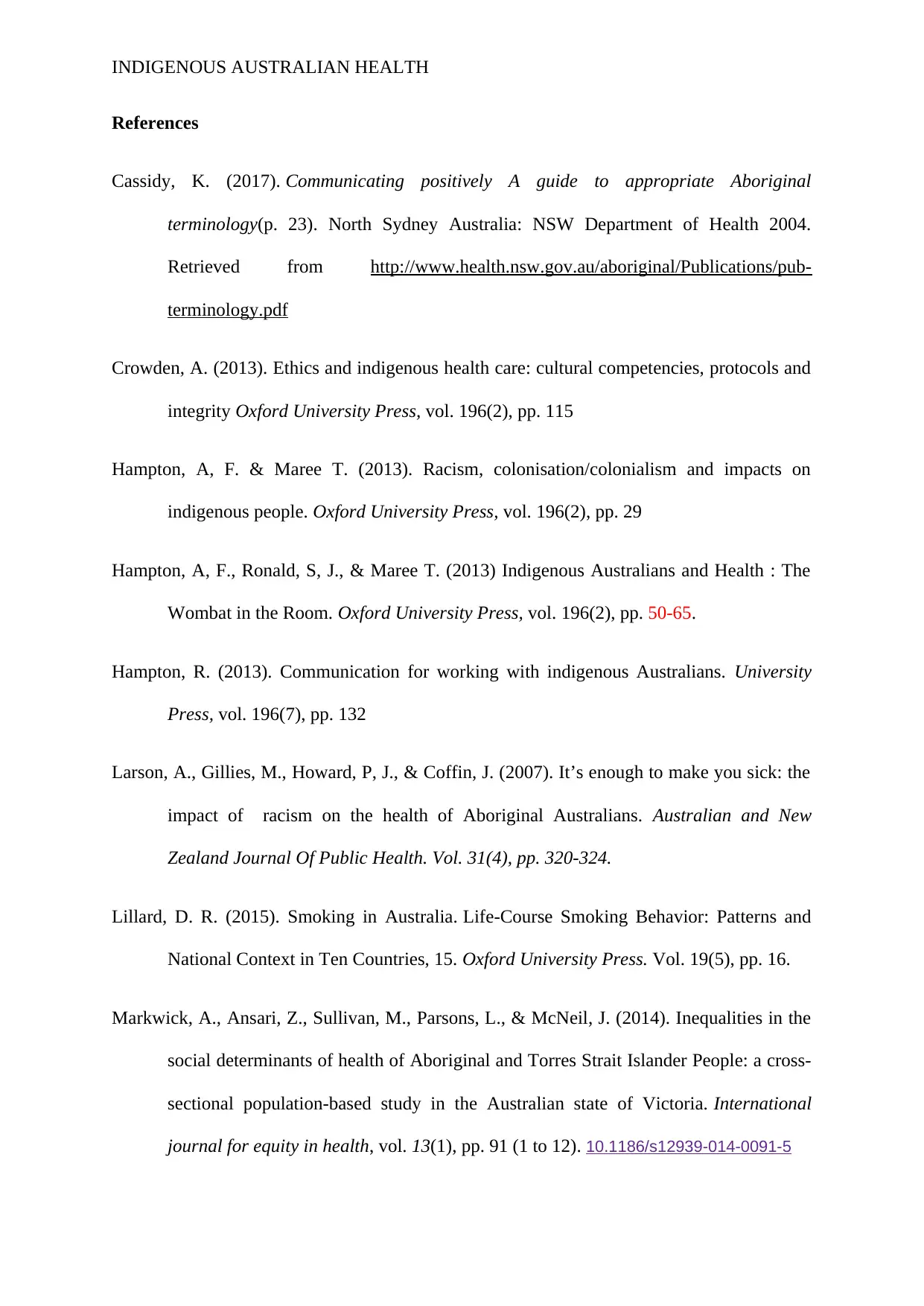
INDIGENOUS AUSTRALIAN HEALTH
References
Cassidy, K. (2017). Communicating positively A guide to appropriate Aboriginal
terminology(p. 23). North Sydney Australia: NSW Department of Health 2004.
Retrieved from http://www.health.nsw.gov.au/aboriginal/Publications/pub-
terminology.pdf
Crowden, A. (2013). Ethics and indigenous health care: cultural competencies, protocols and
integrity Oxford University Press, vol. 196(2), pp. 115
Hampton, A, F. & Maree T. (2013). Racism, colonisation/colonialism and impacts on
indigenous people. Oxford University Press, vol. 196(2), pp. 29
Hampton, A, F., Ronald, S, J., & Maree T. (2013) Indigenous Australians and Health : The
Wombat in the Room. Oxford University Press, vol. 196(2), pp. 50-65.
Hampton, R. (2013). Communication for working with indigenous Australians. University
Press, vol. 196(7), pp. 132
Larson, A., Gillies, M., Howard, P, J., & Coffin, J. (2007). It’s enough to make you sick: the
impact of racism on the health of Aboriginal Australians. Australian and New
Zealand Journal Of Public Health. Vol. 31(4), pp. 320-324.
Lillard, D. R. (2015). Smoking in Australia. Life-Course Smoking Behavior: Patterns and
National Context in Ten Countries, 15. Oxford University Press. Vol. 19(5), pp. 16.
Markwick, A., Ansari, Z., Sullivan, M., Parsons, L., & McNeil, J. (2014). Inequalities in the
social determinants of health of Aboriginal and Torres Strait Islander People: a cross-
sectional population-based study in the Australian state of Victoria. International
journal for equity in health, vol. 13(1), pp. 91 (1 to 12). 10.1186/s12939-014-0091-5
References
Cassidy, K. (2017). Communicating positively A guide to appropriate Aboriginal
terminology(p. 23). North Sydney Australia: NSW Department of Health 2004.
Retrieved from http://www.health.nsw.gov.au/aboriginal/Publications/pub-
terminology.pdf
Crowden, A. (2013). Ethics and indigenous health care: cultural competencies, protocols and
integrity Oxford University Press, vol. 196(2), pp. 115
Hampton, A, F. & Maree T. (2013). Racism, colonisation/colonialism and impacts on
indigenous people. Oxford University Press, vol. 196(2), pp. 29
Hampton, A, F., Ronald, S, J., & Maree T. (2013) Indigenous Australians and Health : The
Wombat in the Room. Oxford University Press, vol. 196(2), pp. 50-65.
Hampton, R. (2013). Communication for working with indigenous Australians. University
Press, vol. 196(7), pp. 132
Larson, A., Gillies, M., Howard, P, J., & Coffin, J. (2007). It’s enough to make you sick: the
impact of racism on the health of Aboriginal Australians. Australian and New
Zealand Journal Of Public Health. Vol. 31(4), pp. 320-324.
Lillard, D. R. (2015). Smoking in Australia. Life-Course Smoking Behavior: Patterns and
National Context in Ten Countries, 15. Oxford University Press. Vol. 19(5), pp. 16.
Markwick, A., Ansari, Z., Sullivan, M., Parsons, L., & McNeil, J. (2014). Inequalities in the
social determinants of health of Aboriginal and Torres Strait Islander People: a cross-
sectional population-based study in the Australian state of Victoria. International
journal for equity in health, vol. 13(1), pp. 91 (1 to 12). 10.1186/s12939-014-0091-5
Secure Best Marks with AI Grader
Need help grading? Try our AI Grader for instant feedback on your assignments.
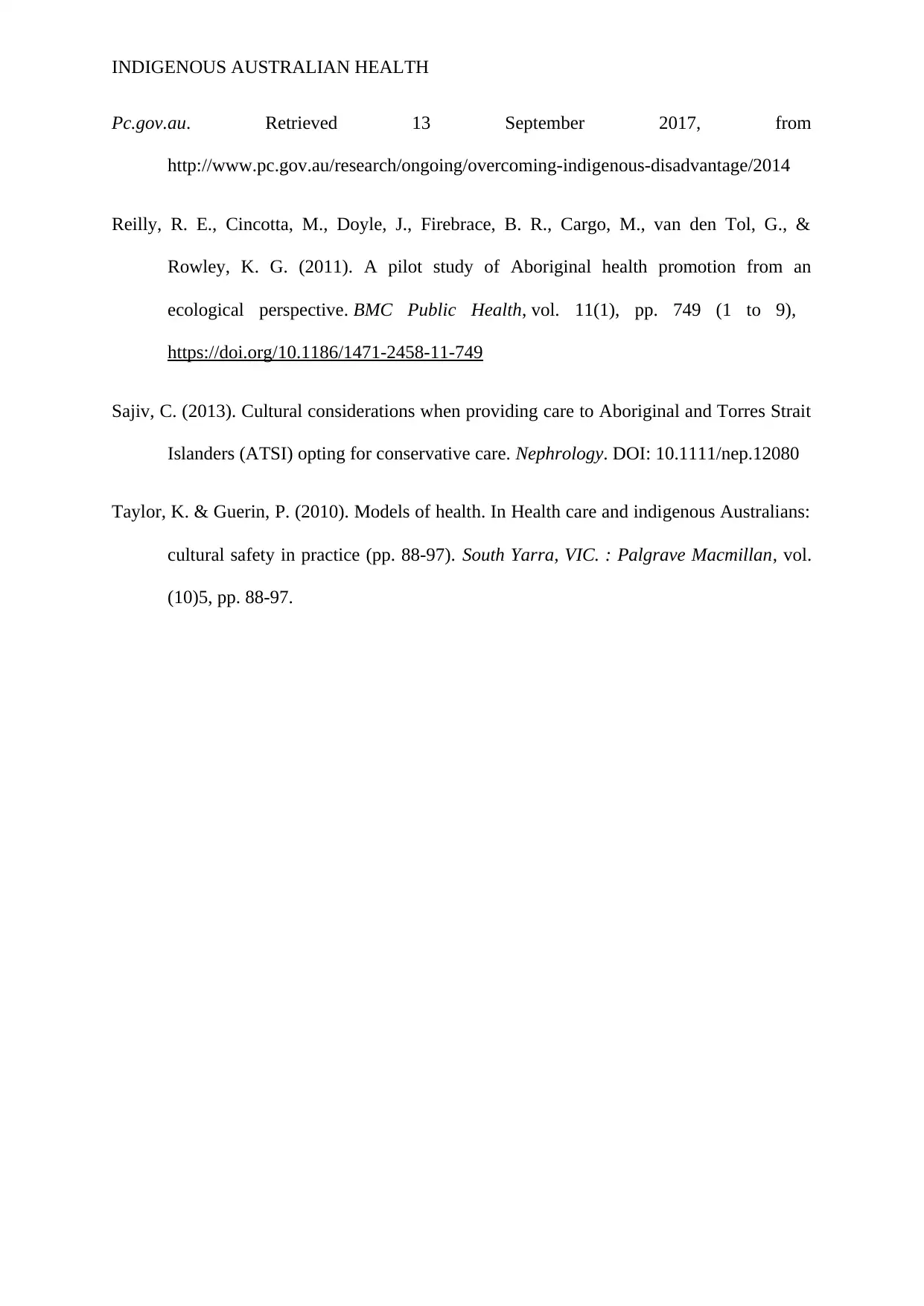
INDIGENOUS AUSTRALIAN HEALTH
Pc.gov.au. Retrieved 13 September 2017, from
http://www.pc.gov.au/research/ongoing/overcoming-indigenous-disadvantage/2014
Reilly, R. E., Cincotta, M., Doyle, J., Firebrace, B. R., Cargo, M., van den Tol, G., &
Rowley, K. G. (2011). A pilot study of Aboriginal health promotion from an
ecological perspective. BMC Public Health, vol. 11(1), pp. 749 (1 to 9),
https://doi.org/10.1186/1471-2458-11-749
Sajiv, C. (2013). Cultural considerations when providing care to Aboriginal and Torres Strait
Islanders (ATSI) opting for conservative care. Nephrology. DOI: 10.1111/nep.12080
Taylor, K. & Guerin, P. (2010). Models of health. In Health care and indigenous Australians:
cultural safety in practice (pp. 88-97). South Yarra, VIC. : Palgrave Macmillan, vol.
(10)5, pp. 88-97.
Pc.gov.au. Retrieved 13 September 2017, from
http://www.pc.gov.au/research/ongoing/overcoming-indigenous-disadvantage/2014
Reilly, R. E., Cincotta, M., Doyle, J., Firebrace, B. R., Cargo, M., van den Tol, G., &
Rowley, K. G. (2011). A pilot study of Aboriginal health promotion from an
ecological perspective. BMC Public Health, vol. 11(1), pp. 749 (1 to 9),
https://doi.org/10.1186/1471-2458-11-749
Sajiv, C. (2013). Cultural considerations when providing care to Aboriginal and Torres Strait
Islanders (ATSI) opting for conservative care. Nephrology. DOI: 10.1111/nep.12080
Taylor, K. & Guerin, P. (2010). Models of health. In Health care and indigenous Australians:
cultural safety in practice (pp. 88-97). South Yarra, VIC. : Palgrave Macmillan, vol.
(10)5, pp. 88-97.
1 out of 11
Related Documents
Your All-in-One AI-Powered Toolkit for Academic Success.
+13062052269
info@desklib.com
Available 24*7 on WhatsApp / Email
![[object Object]](/_next/static/media/star-bottom.7253800d.svg)
Unlock your academic potential
© 2024 | Zucol Services PVT LTD | All rights reserved.





